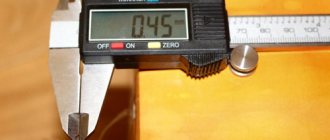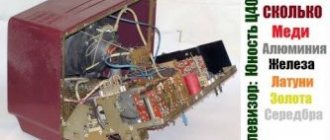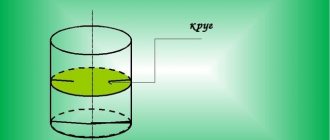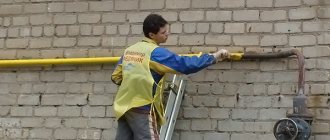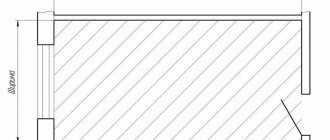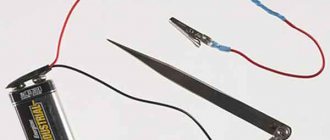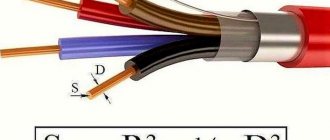If a hexagon has both angles and sides equal, then it is a regular polygon around which only one circle can be described. All the vertices of a hexagon lie on a circle circumscribed around it. A regular hexagon has a center located at an equal distance from its vertices. The center of the hexagon and the center of the circumcircle coincide. The line that connects the center to the vertices is considered the radius of both the polygon and the circumcircle. In a regular hexagon, the side and radius are equal. Hence, R of the circumscribed circle is equal to its side or diagonal, divided in half:
In this expression: a is the size of the side of the hexagon; R is the radius value; d - diagonal.
The online calculator will help you quickly and correctly find the radius value; for this you only need to enter the initial data.
The topic of polygons is covered in the school curriculum, but not enough attention is paid to it. Meanwhile, it is interesting, and this is especially true for a regular hexagon or hexagon - after all, many natural objects have this shape. These include honeycombs and much more. This form works very well in practice.
Definition and construction
A regular hexagon is a plane figure that has six sides of equal length and the same number of equal angles.
If we recall the formula for the sum of the angles of a polygon
it turns out that in this figure it is equal to 720°. Well, since all the angles of the figure are equal, it is not difficult to calculate that each of them is equal to 120°.
Drawing a hexagon is very simple; all you need is a compass and a ruler.
The step-by-step instructions will look like this:
- a straight line is drawn and a dot is placed on it;
- a circle is constructed from this point (it is its center);
- From the intersections of the circle with the line, two more of the same are built, they should converge in the center.
- after this, all points on the first circle are sequentially connected by segments.
If you wish, you can do without a line by drawing five circles of equal radius.
The figure thus obtained will be a regular hexagon, and this can be proven below.
Some facts from history
Geometry was used in ancient Babylon and other states that existed at the same time. Calculations helped in the construction of significant structures, since thanks to it the architects knew how to maintain the vertical, draw up a plan correctly, and determine the height.
Aesthetics were also of great importance, and here geometry came into play again. Today this science is needed by the builder, cutter, architect, and non-specialist too.
Therefore, it is better to be able to calculate S figures, to understand that the formulas can be useful in practice.
Properties are simple and interesting
To understand the properties of a regular hexagon, it makes sense to divide it into six triangles:
This will help in the future to more clearly display its properties, the main of which are:
- circumscribed circle diameter;
- diameter of the inscribed circle;
- square;
- perimeter.
Circumscribed circle and constructability
A circle can be described around a hexagon, and only one. Since this figure is regular, you can do it quite simply: draw a bisector from two adjacent corners inside. They intersect at point O, and together with the side between them form a triangle.
The angles between the hexagon side and the bisectors will be 60°, so we can definitely say that a triangle, for example, AOB, is isosceles. And since the third angle will also be equal to 60°, it is also equilateral. It follows that the segments OA and OB are equal, which means they can serve as the radius of a circle.
After this, you can move to the next side, and also draw a bisector from the angle at point C. You will get another equilateral triangle, with side AB being common to both of them, and OS being the next radius through which the same circle goes. There will be six such triangles in total, and they will have a common vertex at point O. It turns out that it will be possible to describe a circle, and there is only one of it, and its radius is equal to the side of the hexagon:
Read also: Thyristor voltage regulator operating principle
R=a.
That is why it is possible to construct this figure using a compass and ruler.
Well, the area of this circle will be standard:
S=πR²
Inscribed circle
The center of the circumcircle will coincide with the center of the inscribed circle. To verify this, you can draw perpendiculars from point O to the sides of the hexagon. They will be the heights of the triangles that make up the hexagon. And in an isosceles triangle, the height is the median with respect to the side on which it rests. Thus, this height is nothing more than the perpendicular bisector, which is the radius of the inscribed circle.
The height of an equilateral triangle is calculated simply:
h²=а²-(а/2)²= а²3/4, h=а(√3)/2
And since R=a and r=h, it turns out that
r=R(√3)/2.
Thus, the incircle passes through the centers of the sides of a regular hexagon.
Its area will be:
S=3πa²/4,
that is, three quarters of what is described.
Perimeter and area
Everything is clear with the perimeter, it is the sum of the lengths of the sides:
P=6a , or P=6R
But the area will be equal to the sum of all six triangles into which the hexagon can be divided. Since the area of a triangle is calculated as half the product of the base and the height, then:
S=6(а/2)(а(√3)/2)= 6а²(√3)/4=3а²(√3)/2 or
S=3R²(√3)/2
Those who wish to calculate this area through the radius of the inscribed circle can do this:
Entertaining constructions
You can fit a triangle into a hexagon, the sides of which will connect the vertices through one:
There will be two of them in total, and their overlap will give the Star of David. Each of these triangles is equilateral. This is not difficult to verify. If you look at the AC side, it belongs to two triangles at once - BAC and AEC. If in the first of them AB = BC, and the angle between them is 120°, then each of the remaining ones will be 30°. From this we can draw logical conclusions:
- The height ABC from vertex B will be equal to half the side of the hexagon, since sin30°=1/2. Those who want to verify this can be advised to recalculate using the Pythagorean theorem; it fits here perfectly.
- Side AC will be equal to two radii of the inscribed circle, which is again calculated using the same theorem. That is, AC=2(a(√3)/2)=a(√3).
- Triangles ABC, CDE and AEF are equal in two sides and the angle between them, and from this it follows that the sides AC, CE and EA are equal.
Intersecting each other, the triangles form a new hexagon, and it is also regular. This is proven simply:
- Angle ABF is equal to angle BAC. Thus, the resulting triangle with base AB and an unnamed vertex opposite it is isosceles.
- All the same triangles, the base of which is the side of the hexagon, are equal along the side and the adjacent angles.
- The triangles at the vertices of the hexagon are equilateral and equal, which follows from the previous paragraph.
- The angles of the newly formed hexagon are 360-120-60-60=120°.
Thus, the figure meets the characteristics of a regular hexagon - it has six equal sides and angles. From the equality of the triangles at the vertices it is easy to deduce the length of the side of the new hexagon:
d=a(√3)/3
It will also be the radius of the circle described around it. The inscribed radius will be half the size of the side of a large hexagon, which was proven when considering triangle ABC. Its height is exactly half of the side, therefore, the second half is the radius of the circle inscribed in the small hexagon:
Read also: Homemade exhaust fan
r₂=a/2
The area of the new hexagon can be calculated as follows:
It turns out that the area of the hexagon inside the Star of David is three times smaller than that of the large one in which the star is inscribed.
How to find the area of an irregular hexagon
There are several options:
- Breaking down a 6-gon into other shapes.
- Trapezoid method.
- Calculation of S irregular polygons using coordinate axes.
The choice of method is dictated by the initial data.
Trapezoid method
The hexagon is divided into individual trapezoids, after which the area of each resulting figure is calculated.
Using Coordinate Axes
We use the coordinates of the polygon vertices:
- We record the coordinates of the vertices x and y in the table. We select vertices sequentially, “moving” counterclockwise, completing the list by re-recording the coordinates of the first vertex.
- We multiply the x coordinate values of the 1st vertex by the y value of the 2nd vertex, and continue to multiply in this way. Let's add up the results.
- We multiply the coordinate values of the y1st vertex by the x coordinate values of the 2nd vertex. Let's add up the results.
- Subtract the amount received in the 4th stage from the amount received in the third stage.
- We divide the result obtained at the previous stage and find what we were looking for.
From theory to practice
The properties of the hexagon are very actively used both in nature and in various fields of human activity. First of all, this applies to bolts and nuts - the heads of the first and second are nothing more than a regular hexagon, if you do not take the chamfers into account. The size of the wrenches corresponds to the diameter of the inscribed circle - that is, the distance between opposite edges.
Hexagonal tiles have also found their use. It is much less common than the quadrangular one, but it is more convenient to lay it: three tiles meet at one point, rather than four. The compositions can turn out to be very interesting:
Concrete tiles for paving are also produced.
The prevalence of hexagons in nature is simply explained. Thus, it is easiest to fit circles and balls tightly on a plane if they have the same diameter. Because of this, honeycombs have this shape.
Do you know what a regular hexagon looks like? This question was not asked by chance. Most 11th grade students don't know the answer to this.
A regular hexagon is one in which all sides are equal and all angles are also equal.
Iron nut. Snowflake. A cell of a honeycomb in which bees live. Benzene molecule. What do these objects have in common? - The fact that they all have a regular hexagonal shape.
Many schoolchildren get confused when they see problems involving a regular hexagon and believe that some special formulas are needed to solve them. Is it so?
Let's draw the diagonals of a regular hexagon. We got six equilateral triangles.
We know that the area of a regular triangle is: .
Then the area of a regular hexagon is six times greater.
, where is the side of a regular hexagon.
Please note that in a regular hexagon, the distance from its center to any of the vertices is the same and is equal to the side of the regular hexagon.
This means that the radius of a circle circumscribed around a regular hexagon is equal to its side. The radius of a circle inscribed in a regular hexagon is not difficult to find. It is equal. Now you can easily solve any USE problems that involve a regular hexagon.
Did you find what you were looking for? Share with your friends!
. Find the radius of a circle inscribed in a regular hexagon with side .
The radius of such a circle is equal to .
. What is the side of a regular hexagon inscribed in a circle whose radius is 6?
We know that the side of a regular hexagon is equal to the radius of the circle circumscribed around it.
Call us: 8
(free call within Russia)
+7
(free call within Moscow)
Or click on the “Find out more” button to fill out the contact form. We will definitely call you back.
Training video FREE
Technical support: [email protected] (24/7)
A complete online course for preparing for the Unified State Exam in mathematics. Structured. Clearly. Without water. Pass the Unified State Exam with 100 points!
For normal functioning and your convenience, the site uses cookies. This is completely normal practice. By continuing to use the portal, you agree to our Privacy Policy.
All fields are required
Real life examples
Giant hexagon
The giant hexagon is a unique atmospheric phenomenon on Satur that looks like a huge vortex in the shape of a regular hexagon. It is known that the side of the giant hexagon is 13,800 km, thanks to which we can determine the area of the “cloud”. To do this, just enter the side value into the calculator form and get the result:
S = 494,777,633
Thus, the area of the atmospheric vortex on Saturn is approximately 494,777,633 square kilometers. Truly impressive.
Hexagonal chess
We are all accustomed to a chessboard divided into 64 square cells. However, there is also hexagonal chess, the playing field of which is divided into 91 regular hexagons. Let's determine the area of the game board for the hexagonal version of the famous game. Let the side of the cell be 2 centimeters. The area of one game cell will be:
S = 10.39
Then the area of the entire board will be 91 × 10.39 = 945.49 square centimeters.
Premium
The entire part 2 of the Unified State Examination in mathematics, from task 13 to task 19. What even your tutors don’t tell you about. All techniques for solving problems in part 2. Formatting problems for the exam. Dozens of real Unified State Exam problems, from simple to the most complex.
The Premium video course consists of 7 courses for mastering Part 2 of the Unified State Exam in mathematics (problems 13-19). The duration of each course is from 3.5 to 4.5 hours.
- Equations (problem 13)
- Stereometry (problem 14)
- Inequalities (problem 15)
- Geometry (problem 16)
- Financial mathematics (problem 17)
- Parameters (task 18)
- Non-standard problem on numbers and their properties (problem 19).
Read also: Circles for sharpening saw blades
Here is something that is not in textbooks. What they won't tell you at school. Techniques, methods and secrets for solving problems of part 2.
Each topic is analyzed from scratch. Dozens of specially selected tasks, each of which helps to understand the pitfalls and tricks of the solution. The author of the Premium video course is professional tutor Anna Malkova.
Get an A
The video course “Get an A” includes all the topics necessary to successfully pass the Unified State Exam in mathematics with 60-65 points. Completely all tasks 1-13 of the Profile Unified State Exam in mathematics. Also suitable for passing the Basic Unified State Examination in mathematics. If you want to pass the Unified State Exam with 90-100 points, you need to solve part 1 in 30 minutes and without mistakes!
Preparation course for the Unified State Exam for grades 10-11, as well as for teachers. Everything you need to solve Part 1 of the Unified State Exam in mathematics (the first 12 problems) and Problem 13 (trigonometry). And this is more than 70 points on the Unified State Exam, and neither a 100-point student nor a humanities student can do without them.
All the necessary theory. Quick solutions, pitfalls and secrets of the Unified State Exam. All current tasks of part 1 from the FIPI Task Bank have been analyzed. The course fully complies with the requirements of the Unified State Exam 2018.
The course contains 5 large topics, 2.5 hours each. Each topic is given from scratch, simply and clearly.
Hundreds of Unified State Exam tasks. Word problems and probability theory. Simple and easy to remember algorithms for solving problems. Geometry. Theory, reference material, analysis of all types of Unified State Examination tasks. Stereometry. Tricky solutions, useful cheat sheets, development of spatial imagination. Trigonometry from scratch to problem 13. Understanding instead of cramming. Clear explanations of complex concepts. Algebra. Roots, powers and logarithms, function and derivative. A basis for solving complex problems of Part 2 of the Unified State Exam.
Immediately after payment you will receive links to download video courses and unique keys to them.
The tasks of the “Mathematical Trainings – 2019” set are not easy. Each contains interesting tricks, pitfalls, and useful secrets.
The options are designed to cover all possible complex problems of both the first and second parts of the Unified State Examination in mathematics.
How to use?
- There is no need to immediately review the problems (and solutions) of all options. Such cheating will only hinder you. Take one at a time! Solve problems one at a time and try to get to the answer.
- If almost nothing works out, you need to start not with solving the options, but with studying mathematics. A book for preparing for the Unified State Examination and an Annual Online Course will help you.
- If you correctly solved 5-7 problems from the first version of Matttraining, it means that you lack knowledge. See point 1: Books and Annual Online Course!
- Be sure to figure out the right solutions. Watch the video analysis - it also has a lot of useful information.
- You can decide on your own or with friends. Or the whole class. And then watch a video analysis of the option.
The cost of the “Mathematical Trainings – 2019” set is only 1100 rubles. For 5 options with solutions and video analysis of each.
